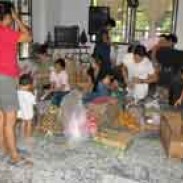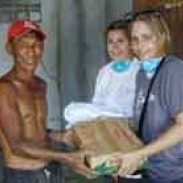You are here
A Personal Account - Tsunami Relief
By the time I arrived in Phuket, coworkers Hanna and Mike had already been there for a couple of days, and had helped with–among other things—translating and orientation for Scandinavian relatives of some of those that were missing.
They had also visited several hospitals to encourage the wounded and were able to pray with many. A friend of the Family from Bangkok was organizing all the volunteer efforts in the local town hall (Salah Klaeng), and she filled us in on where the biggest needs were and how we could best help. As soon as we heard news of the devastation the tsunami wrought, we in Bangkok had begun collecting supplies. Everyone we contacted was willing to contribute—many saying that they were about to call us to volunteer supplies, when we called them. With the help of these likeminded and concerned friends and members of the community, we had gathered enough aid to fill two large 6-wheel-trucks, about 10 tons worth.
Once in Phuket, one of our first tasks was finding out where the supplies could be unloaded, as well as where the food, clothing and other material would best be used. We had heard that the greatest need was in the Khao Lak and Takua Pa areas. Although they were some of the hardest hit districts, they had so far not yet received full attention, because most of the rescue efforts were centered on recovering missing bodies. So we traveled 3 hours along the devastated coastline till we reached Takua Pa.
Through a miracle – and a friend of a friend – we had gotten in touch with a lady in Takua Pa who owned a resort that was totally demolished. It turned out that her husband was a doctor at the small hospital in Takua Pa which had received hundreds and hundreds of wounded the first few days after the disaster occurred. (An article in Thailand’s main newspaper highlighted the wonderful job this small hospital’s staff did, working around the clock 3 days without rest.)
Dr. Seri and his wife, Khun Tip, got in touch with us as soon as we arrived and were desperate for help. They were well aware of the need in this area, being that not much had been channeled there yet. Together we made a plan for unloading the goods and storing them on the hospital grounds. They also offered us any of the materials that the hospital had available to supplement whatever we brought. Khun Tip personally took charge of meeting the driver of our truck and rounding up enough people to unload and store the goods. (This happened around 5 am!)
Then they took us to the most needy areas, where we met with the local village elders to prepare for the distribution over the next couple of days. It was important to do this in an orderly fashion and in conjunction with these dear people who were well aware of the situation on the ground; otherwise, we may have overlooked the most needy people, as Thais are generally quite polite and timid when it comes to requesting assistance.
Part of the miracle of meeting these precious people, and finding out where the biggest needs were was that we could put all our efforts into helping the survivors, not only with physical aid, but, as is more our ministry, giving care and encouragement to those who have to rebuild their lives. By this time most of the other volunteers were needed to help identify the many hundreds of bodies that were found by the rescue crews each day. (Later on this task became overwhelming, especially in trying to identify everyone, with, in one instance, 1600 bodies being brought to one location in a single day.)
After the long trip back to Phuket and a short night’s sleep, we got together to unload the second truck that had arrived during the night, and to sort and organize all the items for distribution. We found out there were several other villages in outlying areas there had also not yet received much-needed aid, among them a small “sea-gypsy” village where the Family had done several projects before.
(This ethnic group of simple and humble people live on their boats most of the year, sailing between the islands in the South East Asia area. The survival of these people despite the tsunami was described as miraculous.—The village elder in seeing the receding waters recalled from old tales that this foretold impending great waves, and rounded up the villagers and helped everyone escape to higher ground. Thus they were all spared.)
After dividing and loading the goods onto our pickup trucks, we made trips throughout the day and into the night to different villages. Each family we met received milk, rice, canned goods, toiletries and cooking utensils. In addition we distributed blankets, mosquito netting, shoes, clothes and children’s mattresses. --Yet another long day.
Early next morning, our whole team headed back to Takua Pa to organize, sort and distribute the remaining goods. By this time the plight of this area had been well covered by the media, causing a great influx of people, organizations and more media, and making traveling on already partially destroyed roads very difficult. Some areas were restricted, due to the urgent efforts of rescue teams to retrieve missing and trapped bodies. But our doctor friend again proved to be a tremendous help in getting through road blocks and to the remote and needy villages.
One small fishing village—where the only buildings left were the local school and a small shophouse that now housed about 200 people—had not received any help whatsoever by the time we got there on Sunday, one week after the disaster. We were again received by these broken, sweet and humble people in such a gracious way that the blessing we received in giving seemed to us to outweigh the aid we were giving to them.
By nature, most Thais are quite composed and collected, and even in such traumatic situations, will rarely openly display their grief, especially to foreigners and strangers. Nevertheless, what their eyes, gestures and few comments conveyed was truly heartbreaking. The waves had stung deep.
As I write this one week after the disaster, the government and other organizations have continued their relief efforts, and the rebuilding has begun. Families who lost their homes have been given temporary housing in tent villages, and we have been specifically asked by the Department of Development and Welfare to help care for the orphaned children and families with young children in these places. This is now the main thrust of our current relief effort, comforting, encouraging and working with the children and young people who have survived this ordeal.
Thank you so much for all your help and support. Although in some cases, the tsunami’s aftermath may not be first page news any more, for the survivors in southern Thailand the realities of daily life and the challenges of restructuring rise with the recurring dawn.
What we were able to give was only temporary relief of course. Much more will be required to enable them to rebuild their homes (we have heard that construction materials are a desperate need) and livelihood. But perhaps what is needed more importantly is vast amounts of encouragement, friendship, comfort moral support and hope for the future—to give them the will to go on living, even though the sea’s force has carved a new path.







